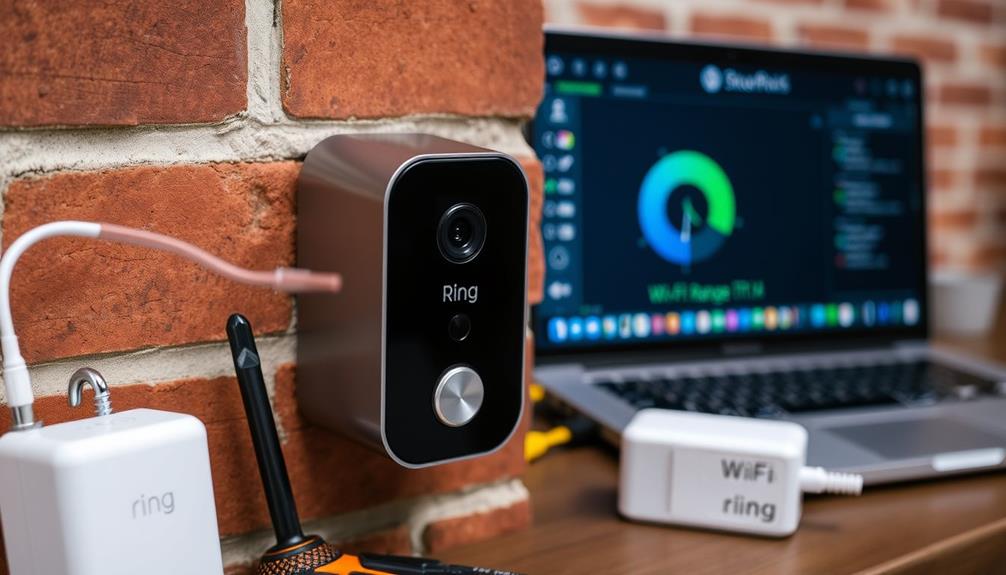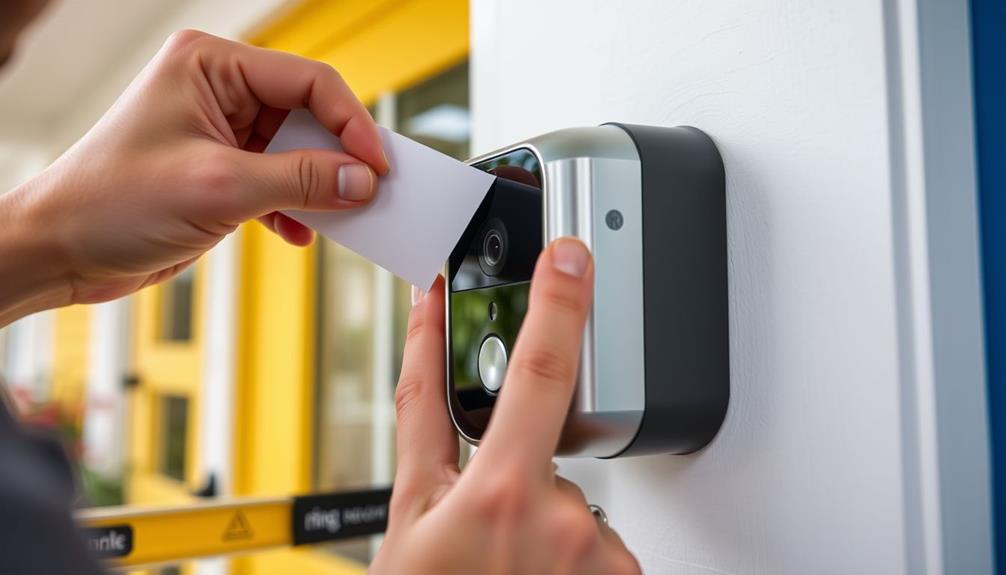To address poor Wi-Fi connectivity with your Ring Doorbell, start by verifying that it is within 200 feet of your router, preferably with a direct line of sight. Raise your router to a height of 8-10 feet to reduce any obstructions such as walls or metal doors. Consider switching from the 5GHz to the 2.4GHz frequency for improved signal penetration through obstacles. Monitor the RSSI value regularly using the Ring app; values over 70 indicate connectivity issues. If problems persist, consider relocating your router or adding Wi-Fi extenders for expanded coverage. There are additional options to explore that can further enhance your connectivity experience.
Key Takeaways
- Ensure the Ring Doorbell is within 200 feet of the router to maintain optimal signal strength and connectivity.
- Elevate the router to at least 8-10 feet to reduce physical obstructions and improve signal reach.
- Switch from the 5GHz band to the 2.4GHz band for better penetration through walls and obstacles.
- Regularly check the RSSI value in the Ring app; aim for values below 70 for better connectivity.
Understanding WiFi Connection Challenges
When you set up your Ring Doorbell, it's essential to understand that various factors can challenge its WiFi connection, leading to frustrating performance issues. One of the main culprits is the WiFi signal strength. If your Ring device is too far from the router, especially beyond 200 feet, you may encounter connection issues. Physical obstructions like walls and metal doors can also degrade the signal notably.
Regular maintenance of your home's air quality, such as using ozone air purifiers, can help reduce allergens and dust that may interfere with electronic devices.
RSSI values are another important aspect to take into account. An RSSI value above 70 typically indicates a weak signal, which can cause latency and connectivity drops, particularly when streaming video. To guarantee ideal Wi-Fi reception, you should position your router strategically and reflect on the layout of your home.
Interference from electronic devices and overcrowded WiFi channels can further exacerbate these issues. If you're experiencing delayed notifications or video feed, you might want to switch from a 5GHz connection to a 2.4GHz connection. The latter often penetrates barriers better and provides a more reliable connection in challenging environments.
Common Causes of Poor Connectivity

When you're experiencing poor connectivity with your Ring Doorbell, router placement and channel interference are often the culprits.
If your router's too far away or surrounded by obstacles, the signal can weaken considerably.
Additionally, crowded Wi-Fi channels can lead to delays in performance, making it essential to address these issues for a better connection.
For instance, ensuring your router is placed in an elevated location can enhance signal strength, similar to how water parks optimize attractions for better visitor experience.
Router Placement Issues
Improper router placement can seriously hinder the Wi-Fi signal strength your Ring Doorbell receives, leading to frustrating connectivity issues.
To guarantee your doorbell functions at its best, aim to place your router within 200 feet of the device. Elevating the router to at least 8 feet can greatly improve Wi-Fi signal reach, as lower placements can cause signal degradation due to obstructions.
Effective keyword clustering can also help in optimizing your network setup by confirming all devices have adequate signal strength.
Be mindful of physical barriers like exterior walls and metal doors, as these can reduce signal strength by over 4 dBm.
Maintaining a clear line of sight between your router and the Ring Doorbell is vital for a strong connection. If you find your connectivity lacking, consider relocating your router to a more central and elevated position. This simple adjustment can lead to noticeable enhancements in performance.
Additionally, avoid placing your router near large appliances or electronic devices that may interfere with the Wi-Fi signal.
Channel Interference Problems
Router placement can only do so much if your Wi-Fi channel is overcrowded, as this interference can lead to delays in video feeds and notifications from your Ring Doorbell.
Understanding the nuances of cybersecurity and ethical hacking can help you appreciate the importance of securing your devices, including smart home technology like the Ring Doorbell.
To tackle channel interference effectively and improve the Wi-Fi connection, consider these steps:
- Analyze Your Wi-Fi Network: Use Wi-Fi Analyzer tools to scan for congested channels. This will help you identify which channels are overcrowded and which are less busy.
- Switch Channels Manually: If your router doesn't automatically switch to less crowded channels, you may need to do it yourself. Opt for channels outside the commonly used ones (1, 6, and 11) for better signal strength.
- Test the Connection: After adjusting the channel, monitor the Ring Doorbell's performance. Check if video feeds and notifications are more responsive.
Optimizing Router Placement

To boost your Ring Doorbell's Wi-Fi connection, you need to pay attention to your router's placement.
Position it within 200 feet of the doorbell and elevate it to at least 8 feet high to avoid obstructions.
Ensuring your router is free from interference will enhance connectivity, similar to how headphone extension cables can reduce audio signal loss.
Also, steer clear of placing it near metal doors or appliances that could block the signal.
Ideal Router Location
Position your Wi-Fi router within 200 feet of the Ring doorbell to enhance connectivity and reduce signal loss. The ideal router location is essential for guaranteeing a strong connection for your Ring. Here are three key tips to improve your router placement:
- Elevate Your Router: Place your Wi-Fi router 8-10 feet high to improve the line of sight to the doorbell and minimize obstructions that can weaken the signal. Additionally, consider the impact of the physical environment on your Wi-Fi performance, as various materials can interfere with signals, leading to connectivity issues. Understanding <a target="_blank" href="https://hourstodaylist.com">general return policies</a> can also provide insight into how to manage any returns related to your Ring device.
- Mind the Materials: Avoid placing the router near metal doors or thick walls. These materials can greatly degrade the Wi-Fi signal, leading to a weaker connection.
- Keep it Clear: Position the router away from other electronic devices that may cause interference. Keeping your router clear of such gadgets helps maintain a stable signal.
After relocating your Wi-Fi router, test the connection to verify improvements in signal strength. Aim for RSSI values below 70 for peak performance. Taking these steps guarantees your Ring doorbell gets the reliable connection it needs to function effectively.
Avoiding Obstructions Nearby
Ensuring your Wi-Fi router has a clear path to the Ring doorbell is vital for avoiding obstructions that can disrupt signal strength.
Position your router within 200 feet of the doorbell to maintain an ideal connection. Avoid placing it near metal doors or other barriers, as these can considerably weaken the 5GHz signal, which struggles with penetration.
To enhance signal distribution, elevate the router to a height of at least 8 feet. This helps minimize interference from walls and furniture that could obstruct the signal. A direct line of sight between the router and the Ring doorbell can boost signal strength, ideally reaching around -40 to -42 dBm, which is essential for consistent performance.
If you're experiencing persistent issues, consider relocating the router to a more central location in your home. This adjustment reduces the impact of physical barriers on your Wi-Fi connection, ensuring stronger and more reliable connectivity.
Enhancing Signal Strength

Improving signal strength for your Ring Doorbell can make a notable difference in its performance and reliability. When you're dealing with poor WiFi, here are three effective strategies to enhance your device connection:
- Switch to 2.4GHz: If your Ring Doorbell is currently connected to a 5GHz network, consider switching to a 2.4GHz connection. This frequency penetrates obstacles like walls and metal doors more effectively, boosting signal strength.
- Relocate Your Router: Position your Wi-Fi router within 200 feet of your Ring Doorbell, ensuring a direct line of sight. This can notably enhance signal strength and reduce latency, leading to a more stable connection.
- Check RSSI Value: Regularly monitor your signal strength by checking the RSSI value. Aim for a value below 70, as higher values indicate weak connectivity that can lead to performance issues.
Using WiFi Extenders and Repeaters

Using WiFi extenders and repeaters can effectively boost your Ring Doorbell's signal strength, making it easier to stay connected. These devices greatly enhance coverage by reducing dead zones in your home, guaranteeing your doorbell functions effectively.
To achieve the best results, position a WiFi extender halfway between your router and the Ring Doorbell. This strategic placement helps bridge the signal gap, maintaining a strong connection.
When setting up your WiFi extender, opt for a model that operates on the 2.4GHz band. This frequency penetrates walls and obstructions more effectively than the 5GHz band, which is essential for maintaining a reliable connection.
Additionally, consider using a Ring Chime Pro. Not only does it extend WiFi coverage, but it also provides audible alerts, enhancing your doorbell's functionality.
Regularly monitor the performance of your WiFi extender to confirm it maintains a strong connection with your Ring Doorbell. If you notice any drop in signal strength, adjust the location of the extender as necessary.
Troubleshooting Connectivity Issues

To troubleshoot connectivity issues with your Ring Doorbell, start by checking the signal strength in the Ring app for an RSSI value below 70. If the value is higher, it indicates potential problems that you can fix.
Here are a few steps to help improve your connection:
- Relocate Your Router: Move your router within 200 feet of the Ring device, ensuring minimal barriers like walls or metal doors that could weaken the signal.
- Switch Bands: If issues persist, consider switching to the 2.4GHz band. This band generally penetrates barriers better than the 5GHz band.
- Use WiFi Extenders: Install WiFi extenders or a Ring Chime Pro to enhance the signal path. This can help reduce connectivity drops caused by distance or obstructions.
Regularly assess potential channel interference using WiFi Analyzer tools. Adjusting your router settings to avoid crowded channels (1, 6, 11) can also improve connection stability.
Engaging With the Ring Community

Engaging with the Ring Community opens up a wealth of shared knowledge and solutions from fellow users who've faced similar Wi-Fi connectivity challenges.
By logging into the Ring app or creating an account, you can immerse yourself in discussions, ask questions, and tap into a treasure trove of collective wisdom regarding connectivity issues.
Many users share their personal experiences and successful strategies for improving Wi-Fi connectivity, which can be invaluable when troubleshooting your own device. You might discover tips and tricks that aren't mentioned in official support articles, giving you an edge in resolving your problems.
Active participation not only enhances your understanding but also fosters a supportive environment where you can receive encouragement from those who've been in your shoes.
The Ring Community is a place where you can connect with others, making the journey to better connectivity feel less isolating.
Frequently Asked Questions
Why Does My Ring Doorbell Keep Saying Poor Wifi Connection?
If your Ring Doorbell keeps saying it has a poor Wi-Fi connection, it's likely due to weak signal strength.
This often happens if the device is too far from your router or blocked by walls and metal objects.
You might also be dealing with overcrowded Wi-Fi channels or interference.
Checking these factors can help you understand why the connection drops and what you can do to improve it for better performance.
How Can I Boost My Ring Wifi Signal?
To boost your Ring Wi-Fi signal, switch to a 2.4GHz connection for better penetration through walls.
Place your router within 200 feet of the device and elevate it to reduce obstructions.
Consider using a Wi-Fi extender or a Ring Chime Pro to enhance signal strength.
Regularly check the RSSI values in the Ring app, aiming for below 70, and experiment with different 2.4GHz channels to avoid interference from other networks.
How Do I Fix a Poor Connection on My Ring Camera?
To fix a poor connection on your Ring camera, start by checking the RSSI value in the app; a value above 70 means you need to improve your signal.
Try moving your Wi-Fi router closer, ensuring it's within 200 feet with minimal obstructions.
If needed, switch to the 2.4GHz band for better penetration.
You might also consider adding Wi-Fi extenders or a Ring Chime Pro to boost the coverage.
Why Does My Ring Doorbell Keep Losing Connection?
You might notice your Ring Doorbell keeps losing connection, like when your neighbor, Sarah, had constant issues after moving her router to the basement.
This can happen due to weak Wi-Fi signals, especially if the RSSI value is above 70.
Physical barriers, like walls, can block the signal, and overcrowded channels might delay notifications.
You should check router placement and consider switching to a less congested channel for better performance.
Conclusion
To sum up, fixing your Ring doorbell's poor WiFi connection can greatly enhance its performance and your home security.
Did you know that a strong WiFi signal can improve device functionality by up to 50%?
By optimizing your router placement and considering WiFi extenders, you can boost connectivity.
Don't hesitate to share your experiences and solutions with the Ring community, as collective knowledge can lead to better connections for everyone.
Your doorbell deserves the best signal!









